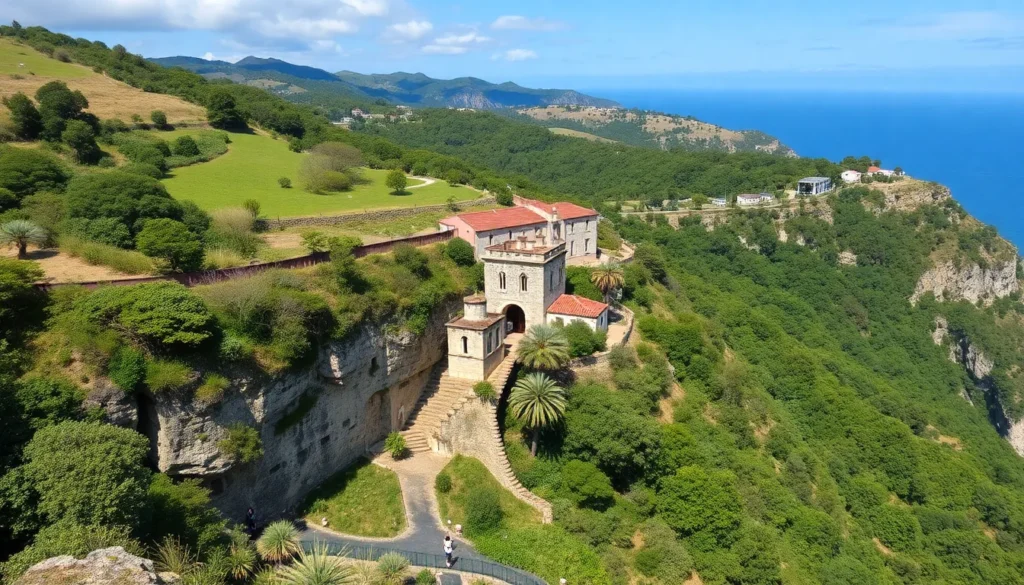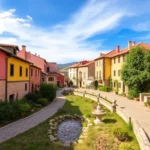10 Must-See Places on the Costa da Morte

- The intriguing name of Costa da Morte
- 1. Finisterre: The End of the Earth
- 2. Hórreo de Carnota and Ézaro Waterfall
- 3. Muros: A Charming Fishing Village
- 4. Lires and Playa de Nemiña: Hidden Gems
- 5. Muxía: A Spiritual Retreat
- 6. Camariñas: The Heart of Fishing Culture
- 7. Laxe: A Coastal Delight
- 8. Route of the Dolmens of Vimianzo
- 9. Faro Roncudo: A Beacon of Heritage
- 10. Malpica: A Picturesque Finale
- Map of Must-Visit Sites in Costa da Morte
- Our Experience and Recommendations for Visiting Costa da Morte
The Costa da Morte, or "Coast of Death," is a region that, despite its ominous name, is a breathtaking treasure trove of natural beauty, rich history, and cultural significance. With its rugged cliffs, stunning beaches, and quaint fishing villages, this part of Galicia has much to offer for those adventurous enough to explore its shores. Are you ready to discover what to see and do in this captivating corner of the world?
In this guide, we will take you through ten must-see spots along the Costa da Morte, along with essential tips to help you make the most of your visit. Let's dive into the enchanting experiences waiting for you on the stunning Costa da Morte!
The intriguing name of Costa da Morte
The name “Costa da Morte” derives from the treacherous waters of the Atlantic Ocean that have claimed numerous ships and lives throughout history. Despite the dangers, this coastline is now a serene paradise that draws travelers from all over the globe. The richness of its landscapes and cultural heritage far outweighs the dark connotations of its name, making the Costa da Morte a unique destination for any traveler.
1. Finisterre: The End of the Earth
Our journey begins at Finisterre (Fisterra), a place steeped in myth where land meets the ocean. Known as the “Land's End” by the Romans, it is the final stop for many pilgrims on the Camino de Santiago. Standing at the iconic Faro de Finisterre, you can gaze out at the vast expanse of the Atlantic Ocean, feeling as if you are standing on the edge of the world.
Take a stroll through the charming town of Finisterre. Although it may not be the most picturesque in Galicia, it offers delightful restaurants and vibrant local culture. Be sure to try the renowned octopus at O Pirata and visit the emotional monument to the emigrant, commemorating those who left their homeland in search of a better life.
Don’t miss Playa de Langosteira with its crystal-clear waters, perfect for a refreshing dip. This beach is often regarded as one of the best in Galicia for its stunning scenery and inviting atmosphere.
* If you don’t have a car, consider taking a guided tour from Santiago de Compostela to Finisterre.
2. Hórreo de Carnota and Ézaro Waterfall
A short detour from Finisterre leads you to the hórreo de Carnota, one of the longest granaries in Galicia, measuring an impressive 34 meters. Nearby, the Playa de Carnota stretches for 7 kilometers, making it the longest beach in the region and a stunning spot for sunbathing along the Costa da Morte.
Continue your journey to the breathtaking Cascada de Ézaro, where the river flows dramatically into the ocean. The sight is even more magical if you catch local musicians performing traditional tunes, adding to the enchanting atmosphere. For adventure seekers, kayaking tours are available, allowing you to experience the beauty of the waterfall from a unique perspective.
3. Muros: A Charming Fishing Village
No visit to the Costa da Morte would be complete without exploring Muros, a picturesque fishing village that encapsulates the charm of the region. This quaint town is often debated as being part of the Costa da Morte or Rías Baixas, but its scenic beauty and vibrant harbor make it a must-see.
Be sure to visit the Playa de Louro, known for its stunning views and serene environment, perfect for a leisurely day by the sea in the beautiful Costa da Morte.
As you head north, the little village of Lires awaits. This charming spot is close to the beautiful Playa de Nemiña, renowned for its fine white sand and clear waters. This beach is a hidden gem that is perfect for those looking to escape the crowds in the Costa da Morte.
While in the area, consider visiting the Faro de Touriñán, the most western point of the Spanish mainland, offering stunning coastal views that showcase the rugged beauty of the Costa da Morte.
5. Muxía: A Spiritual Retreat
Next on your journey is Muxía, famous for its Santuario da Virxe da Barca, which is steeped in legend. It is said that the Virgin Mary arrived here to encourage the Apostle James. Every September, a pilgrimage takes place, bringing together locals and visitors to honor this sacred site.
Among the rocks surrounding the sanctuary is the Pedra dos Cadrís, known for its supposed healing powers. Local lore suggests that passing under it nine times will alleviate back pain and kidney ailments. Make sure to visit the Miradoiro Jesus Quintanal for breathtaking views of the coastline of the Costa da Morte.
Exploring Muxía wouldn’t be complete without taking in its stunning beaches, such as Praia de Lourido, where the contrast of the blue ocean against the lush green landscape is simply mesmerizing.
6. Camariñas: The Heart of Fishing Culture
Known for its rich maritime history, Camariñas is a vibrant fishing village that also boasts the stunning Faro de Cabo Vilán. The sunsets here are said to be among the most beautiful in Spain. Make sure to explore the museum housed within the lighthouse, which tells the story of the many shipwrecks that have occurred in these treacherous waters of the Costa da Morte.
Nearby is the Cementerio de los Ingleses, a poignant memorial to the sailors lost in the naufragio del Serpent in 1890, where only a few survived. If time allows, embark on a hiking route from Arou that spans 15 kilometers and includes breathtaking coastal views.
7. Laxe: A Coastal Delight
While we didn’t have time to fully explore Laxe, its Praia de Laxe is worth a visit. This beach is not only beautiful but also offers a unique perspective of the coast. Just a kilometer away lies the notable Playa de los Cristales, where smooth glass fragments create a dazzling spectacle. This beach's beauty is a result of nature's recycling process, turning trash into treasure along the Costa da Morte.
Don’t forget to stop at the Miradoiro das Grelas for a stunning vista of the Ensenada de Lodeiro as you continue your exploration.
8. Route of the Dolmens of Vimianzo
Venture inland to discover the historical Route of the Dolmens of Vimianzo, where you can explore up to nine megalithic monuments from the Neolithic era. This site is considered the most significant of its kind in Galicia. The Dolmen de Dombate is often referred to as the “cathedral of megalithism in Galicia” and is a must-visit, alongside the nearby Dolmen Pedra da Arca.
While in Vimianzo, take the time to visit the impressive local castle, which features distinct defensive architecture and adds to the area's historical allure.
9. Faro Roncudo: A Beacon of Heritage
Named for the sound of waves crashing against the rocks, Faro Roncudo is another important lighthouse along the coast. This area is famous for its percebes, considered some of the best in the world. Observing the percebeiros (goose barnacle gatherers) in action is a sight to behold, as they scale the rocks to harvest this prized delicacy along the rugged shores of Costa da Morte.
As you visit, you may see memorial crosses dedicated to those who have lost their lives in pursuit of this dangerous profession, serving as a somber reminder of the ocean’s might.
10. Malpica: A Picturesque Finale
Our final stop takes us to Malpica, a lively fishing port that offers a delightful mix of history and scenic beauty. The Iglesia de San Adrián provides stunning views of the rugged coastline and is a great spot to reflect on your journey along the Costa da Morte. The vibrant atmosphere and local culture make Malpica a fitting conclusion to your exploration of this extraordinary region.
Map of Must-Visit Sites in Costa da Morte
To assist you in your travels, here is a map highlighting the essential locations to explore during your visit to the Costa da Morte:
Our Experience and Recommendations for Visiting Costa da Morte
During our visit, we made the mistake of trying to cover the Costa da Morte in just one day, which proved to be quite a challenge. We started our circular route from Santiago de Compostela and even took time to enjoy breakfast in A Coruña. In total, we spent around 12 intense hours on the road.
While we didn’t drive long distances, we learned the hard way that dedicating just one day is not ideal for experiencing the beauty of this area. If you have the chance, consider spending at least two or even three days in the region, as the Costa da Morte has so much to offer.
Suggested 3-Day Itinerary for Costa da Morte
Here’s our perfect plan for a three-day trip along the Costa da Morte:
- Day 1: Explore the area between Muros and Finisterre
- Day 2: Discover the stretch from Finisterre to Muxía
- Day 3: Venture from Muxía to Malpica
Reflecting back on our whirlwind day, we cherish the memories and the many places we managed to see, despite not having enough time to fully enjoy each stop.
For further insights, check out this article from our friend Eviña, who knows the region intimately!
These are our top recommendations, but what about you? Do you have any additional suggestions for things to see and do in the Costa da Morte?
Save on your trip
- Compare and find cheap flights here
- Find accommodation at the best prices here
- Book activities and excursions in Spanish here
- Get a 5% discount on your travel insurance with IATI here
- Book airport transfers here
- Receive a 10€ gift when booking transport across Europe here
- Learn how to withdraw money without commissions here
- Get a 5% discount on your eSIM from Holafly here
- Rent a car at the best deals here
- Compare prices for van rentals here
- Find the best travel books and guides here
- Explore all our articles about Spain
Shutterstock: photo of Dolmen de Dombate, Playa de Nemiña, Faro de Cabo Vilán and Faro Roncudo.





Deja una respuesta